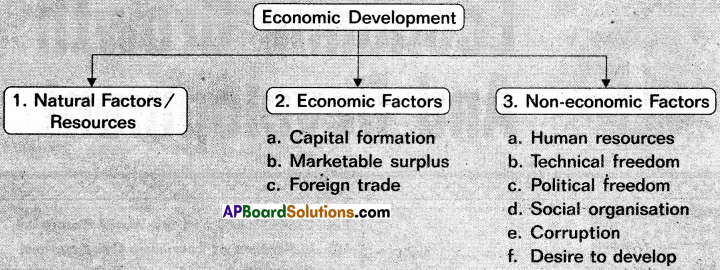Students can go through AP Inter 2nd Year Economics Notes 1st Lesson Economic Growth and Development will help students in revising the entire concepts quickly.
AP Inter 2nd Year Economics Notes 1st Lesson Economic Growth and Development
→ The increase in the real output of goods and services is called Economic growth.
→ Economic growth with progressive changes in the socio-economic structure of a country is called Economic development.
→ The world bank report 2014 classified countries on the basis of their percapita income. They are divided into
- Low income countries,
- Middle income countries,
- High income countries.
→ The economic indicators help to analyse the working of the economy. They are :
- Real National Income,
- Real per capita Income,
- Standard of Living.
![]()
→ Physical Quality of Life Index (PQLI) calculated on the basis of 3 parameters of
- Life expectancy,
- Infant mortality rate,
- Literacy rate.
→ Human Development Index (HDI) is a composite index of three parameters are
- Life expectancy,
- Adult literacy rate,
- Standard of living.
→ Determinants of economic development are :
- Natural resources,
- Economic factors,
- Non-economic factors.
→ Characteristic features of a developed economy – High per capita income – Importance of non-agricultural sector – Capital formation A technology – Low level of unemployment – Better quality of life.
![]()
→ Characteristic features of developing countries – Low per capita income – Scarcity of capital – Demographic characteristics – Unemployment – Predominance of agriculture – Poverty – Income inequalities – Technological backwardness – Population – Dual economy – Price instability.

→ Economic growth : Economic growth refers to an increase in a country’s real output of goods and services.
→ Economic development: It refers to not only economic growth but also progressive changes in the socio-economic structure of a country.
→ Per capita income : It is obtained by dividing the National income with population of the country.
Per capita income = \(\frac{\text { National income }}{\text { Population }}\)
→ The Quantitative or Physical increase in the real output of goods and services in a country is generally referred as Economic Growth.
→ Economic Development, a broad concept, refers to a long term process in which an Economy’s real national income increases over a long period of time. Being a broad concept, it covers both Quantitative changes and Qualitative improvements.
→ Basing on per capita GNI, the World Bank has divided the world countries into three categories namely — Low Income Countries, Middle Income countries consisting of Lower Middle Income countries and upper middle income countries and High Income Countries.
→ The important determinants of Economic Development of a country are — Natural Resources, Economic factors comprising of rate of capital formation, Extent of marketable surplus, Volume of foreign trade and Non-Economic factors consisting of size and quality of human resources, Technological progress in the Economy, Political freedom, Social organisation, corruption level in the society and urge or desire of the people to develop.
→ The important features of Developing Economics are — High per capita Income, Importance of Non-Agricultural sectors, Abundance of capital and technology, Low level of Unemployment, Better quality of life.
→ The important features of Developing Economics are – Scarcity of capital Demographic characteristics, Unemployment, Predominance of agriculture, High incidence of poverty, Technological backwardness, High density of population, Dual Economy, Price Instability.
→ దీర్ఘకాలంలో వస్తుసేవల వాస్తవిక ఉత్పత్తి క్రమంగాను, స్థిరంగాను పెరుగుతున్నట్లైతే దీన్ని ఆర్థికవృద్ధి అంటారు. ఇది ఒక దేశంలోని స్థూల దేశీయ ఉత్పత్తి (GDP) లేదా జాతీయాదాయములో పెరుగుదల శాతంగా కొలవబడుతుంది. ఒక దేశంలో జనాభా పెరుగుదలరేటు కంటే వాస్తవిక ఉత్పత్తిలో పెరుగుదలరేటు ఎక్కువగా ఉంటే ఆర్థికవృద్ధి చెందుతున్నట్టుగా చెప్పవచ్చును.
→ ఆర్థికాభివృద్ధి అనే భావన ఆర్థికవృద్ధి కంటే చాలా విస్తృతమైనది. ఇది ఒక దేశంలోని ఆర్థికవృద్ధితోపాటు, సాంఘిక, ఆర్థిక, వ్యవస్థాపూర్వక మార్పులను సూచిస్తుంది. ఆర్థికాభివృద్ధి పరిమాణాత్మకం మరియు గుణాత్మకమైనది.
→ 1960 సం|| వరకు ఆర్థికవృద్ధి, ఆర్థికాభివృద్ధి అనే భావనలు పర్యాయపదాలుగా వాడటం జరిగింది. అయితే హిక్స్, షుంపీటర్ లాంటి ఆర్థికవేత్తలు ఈ రెండు పదాలకు వేర్వేరు అర్థాలను ఇస్తూ వాటి మధ్య స్పష్టమైన తేడాలను సూచించారు.
→ ఆర్థికాభివృద్ధిని దేశంలోని శ్రమ శక్తి యొక్క పరిమాణం, నాణ్యత, సహజవనరుల లభ్యత, మూలధన కల్పన, విక్రయించగా గల మిగులు, విదేశీ వ్యాపారము, సాంకేతిక ప్రగతి, నవకల్పనలు, రాజకీయ స్వాతంత్ర్యం సామాజిక వ్యవస్థ, అవినీతి, అభివృద్ధి చెందాలనే ప్రజల కోరిక మొదలైనవి ప్రభావితం చేస్తాయి.
→ అభివృద్ధి చెందిన దేశాలు అధిక తలసరి ఆదాయము, వ్యవసాయేతరంశాల ప్రాధాన్యత. అధికస్థాయిలో మూలధనము సాంకేతిక విజ్ఞానము, తక్కువ స్థాయిలో నిరుద్యోగము, మెరుగైన జీవన ప్రమాణము మొదలైన లక్షణాలను కలిగి ఉంటాయి.
![]()
→ ప్రపంచబ్యాంకు తలసరి స్థూల జాతీయాదాయం ప్రకారం ప్రపంచదేశాలను వర్గీకరించింది. తలసరి GNI1,045 డాలర్లు లేదా అంతకంటే తక్కువ తలసరి GNI ఉన్న దేశాలను తక్కువ ఆదాయం గల దేశాల తలసరి GNI1,046 డాలర్లు కంటే ఎక్కువగాను, 12,746 డాలర్లు కంటే తక్కువ ఉన్న దేశాల మధ్య ఆదాయం గల దేశాలు. తలసరి GNI 12,747 డాలర్లు కంటే ఎక్కువగా ఉండే దేశాలు అధికాదాయం గల దేశాలు.
→ ఆర్థిక మాపనలు ఆర్థిక కార్యకలాపాలను సూచించే గణాంకాలు ఆర్థిక వ్యవస్థ యొక్క పనితీరును విశ్లేషించడానికి ఆర్థిక మాపనలు ఉపయోగపడతాయి. వాస్తవిక జాతీయాదాయం, వాస్తవిక తలసరి ఆదాయం జీవన ప్రమాణం అనేవి కొన్ని ఆర్థిక మాపనలు.
→ ఆర్థిక మాపనలలో లోపాల వలన వివిధ రకాల సూచికలు ప్రతిపాదించబడినాయి. అవి భౌతిక జీవన ప్రమాణ సూచిక (PQLI), ఆర్థిక సంక్షేమ కొలమానం (MEW), నికర ఆర్థిక సంక్షేమ సూచిక (NEW). మానవాభివృద్ధి సూచిక (HDI).
→ అభివృద్ధి చెందుతున్న దేశాలు తక్కువ తలసరి ఆదాయం, మూలధనం కొరత, జనాభా లక్షణాలు, నిరుద్యోగం, వ్యవసాయరంగ ప్రాధాన్యత, సామూహిక పేదరికం, ఆదాయ అసమానతలు, తక్కువ జీవనప్రమాణము, సాంకేతిక వెనుకబాటుతనం, అధిక జనసాంద్రత, ఆర్థిక ద్వంద్వత్వము, ధరల అస్థిరత్వం మొదలైన లక్షణాలు కలిగి ఉన్నాయి.
→ ఆర్థికపరమైన ఒక విరామ స్థితిని సమతౌల్యం అంటారు.
→ ఒక వ్యక్తి లేదా సమాజం సంపద నుండి పొందే సంతృప్తిని తెలియజేస్తుంది సంక్షేమం.
→ ఆర్థికవృద్ధి అనేది ఒక దేశం యొక్క వాస్తవిక వస్తు సేవల ఉత్పత్తిలో పెరుగుదల సూచిస్తుంది. ఇది పరిమాణాత్మకమైనది.
→ ఆర్థికాభివృద్ధి అనేది ఆర్థికవృద్ధితో పాటు సాంఘిక మరియు ఆర్థిక నిర్మాణాలలో ప్రగతిశీల మార్పులను తెలియజేయును.
→ ఆర్థిక మాపనలు ఆర్థిక కార్యకలాపాలను సూచించే గణాంకాలు. అవి :
- వాస్తవిక జాతీయాదాయం
- వాస్తవిక తలసరి ఆదాయం
- జీవన ప్రమాణం.
→ ఆర్థికాభివృద్ధిని నిర్ణయించే అంశాలు:
- సహజ వనరులు
- ఆర్థిక అంశాలు
- ఆర్థికేతర అంశాలు
→ అభివృద్ధి చెందిన దేశాల లక్షణాలు – అధిక తలసరి ఆదాయం, వ్యవసాయేతర ఋజాల ప్రాధాన్యం, అధిక స్థాయిలో మూలధనం, సాంకేతిక జ్ఞానం, తక్కువ స్థాయిలో నిరుద్యోగం, మెరుగైన జీవన ప్రమాణం.
→ అభివృద్ధి చెందుతున్న దేశాల లక్షణాలు – తక్కువ తలసరి ఆదాయం, మూలధన కొరత, జనాభా లక్షణాలు, నిరుద్యోగం, వ్యవసాయేతర రంగాల ప్రాముఖ్యత, సామూహిక పేదరికం, ఆదాయ అసమానతలు, తక్కువ జీవన ప్రమాణం, సాంకేతిక వెనుకబాటుతనం, అధిక జనసాంద్రత, ఆర్థిక ద్వంద్వత్వం, ధరల అస్థిరత్వం.
